PSG are out of the 2022/23 UEFA Champions League and yet again, it raises major questions about the overall strategy on display from the Qatar-led project.
There’s no shame in dropping out of Europe’s elite competition against Bundesliga giants Bayern Munich but it’s the manner in which their defeat came about — a 3-0 defeat on aggregate and, ultimately, an uninspiring display over two legs — that is, perhaps, the greatest cause of concern for the Ligue 1 leaders.
PSG were denied on a couple of occasions on Wednesday by some brilliant Bayern defensive work. Vitinha had a great opportunity cleared from the goal line by former Ajax and Juventus centre-back Matthijs de Ligt, while 2022 FIFA World Cup hero Lionel Messi was denied a golden opportunity by some clutch Alphonso Davies tackling.
Overall, though, Les Parisiens’ performance was dull, at times lifeless and unbecoming of a team that’d like to see themselves as one of Europe’s elite, but continuously falls short when tasked with doing what elite clubs do and delivering on the grandest stage.
This tactical analysis will not just be a post-mortem of PSG’s UCL exit and tactics on Wednesday, but also a team-focused scout report providing a dissection of wider problems within their team that have plagued the squad this term — and which, certainly, have come to light in recent games, including on Wednesday.
PSG’s defensive approach
It’s been explained and done to death but it’d be impossible to look at this PSG team and their struggles of late, including their drop out of the UCL, without discussing their defensive approach.
At the end of the day, defending with eight/nine outfield players — maximum — due to the lack of defensive output from the star men up top is always going to be a weakness and it’s something that teams have been able to exploit time and time again when coming up against Les Parisiens over the past couple of seasons.
They don’t commit many defensive actions at all, engaging in few defensive duels and pulling off few interceptions, while they’ve got a relatively average PPDA — all signs that point to a team defending rather passively.
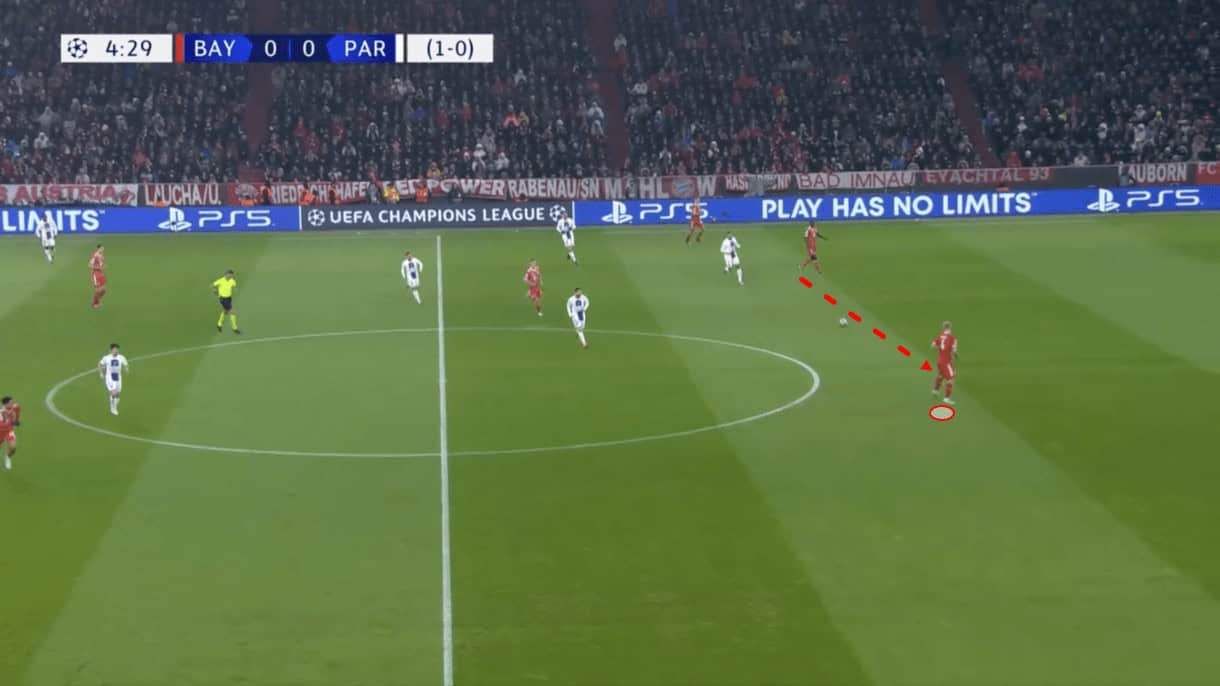
The negatives to this versus Bayern were abundantly clear, as Julian Nagelsmann’s men prepared well to exploit their French opponents via the deep half-space areas where you typically found Kylian Mbappé and Lionel Messi patrolling without the ball, maintaining their team’s defensive structure, sure, but offering very little in terms of actually regaining possession.
In figure 1, we see Bayern switching the play from right to left, getting De Ligt on the ball with Messi as the nearest PSG player. This gives De Ligt plenty of time to weigh up his next move and plan his team’s progression.
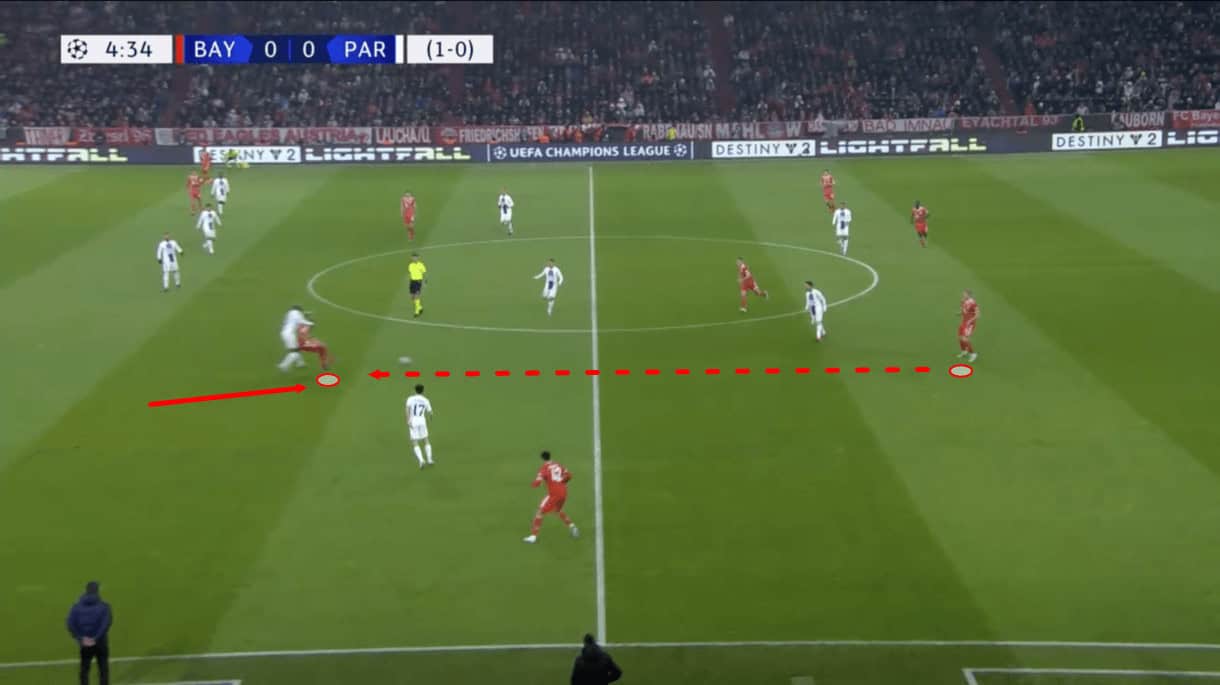
With all the time and space afforded to him, De Ligt is able to pick out an attacking teammate dropping deeper in the same channel but further upfield, playing the ball to him and beyond PSG’s midfield line.
Danilo Pereira, at right centre-back, followed the attacker deep and ended up giving a foul away, letting Bayern gain some territory and enjoy a set-piece opportunity just inside PSG’s half.
The consequences could’ve been worse, but it’s still not an ideal result. In any event, it proved far too easy for Bayern to play past PSG’s forward line and, indeed, midfield line on Wednesday.
Giving a player like De Ligt so much time and space on the ball and giving a team like Bayern so many opportunities to progress into your half will only result in too many goalscoring opportunities conceded.
It’s a gamble playing with these attackers as you have to hope what they contribute offensively can outweigh their poor defensive contribution, which was not the case here. Quality of pressing and intelligent defensive organisation is increasingly becoming more and more of a key deciding factor in big games at the elite level and PSG will generally lose out on that front.
In possession part 1: Lack of ball progression
PSG have kept the second-most possession in Ligue 1 this season (59.5%) and have played the most passes (597.3 per 90); they have the best pass accuracy at 90.5%.
In the Champions League, PSG have the ninth-highest possession percentage (54.5%) and have played the fourth-most passes (557.77) while maintaining a 90.4% pass accuracy rate.
Despite that, PSG have played the sixth-fewest progressive passes in Ligue 1 (62.63 per 90) and the fewest progressive passes in the Champions League (54.23 per 90).
They struggle to progress the play very much. They have a lot of players who want the ball to feet and enjoy building the attack slowly and cautiously but this leads to laboured build-up with not much risk-taking. This can extend into needlessly long periods of possession with little progress made towards creating a goalscoring chance.
PSG’s pass maps from their two legs versus Bayern Munich paint a pretty grim picture. The first (on the left) is from their home leg and shows that they really struggled to have much time on the ball centrally in advanced areas at all.
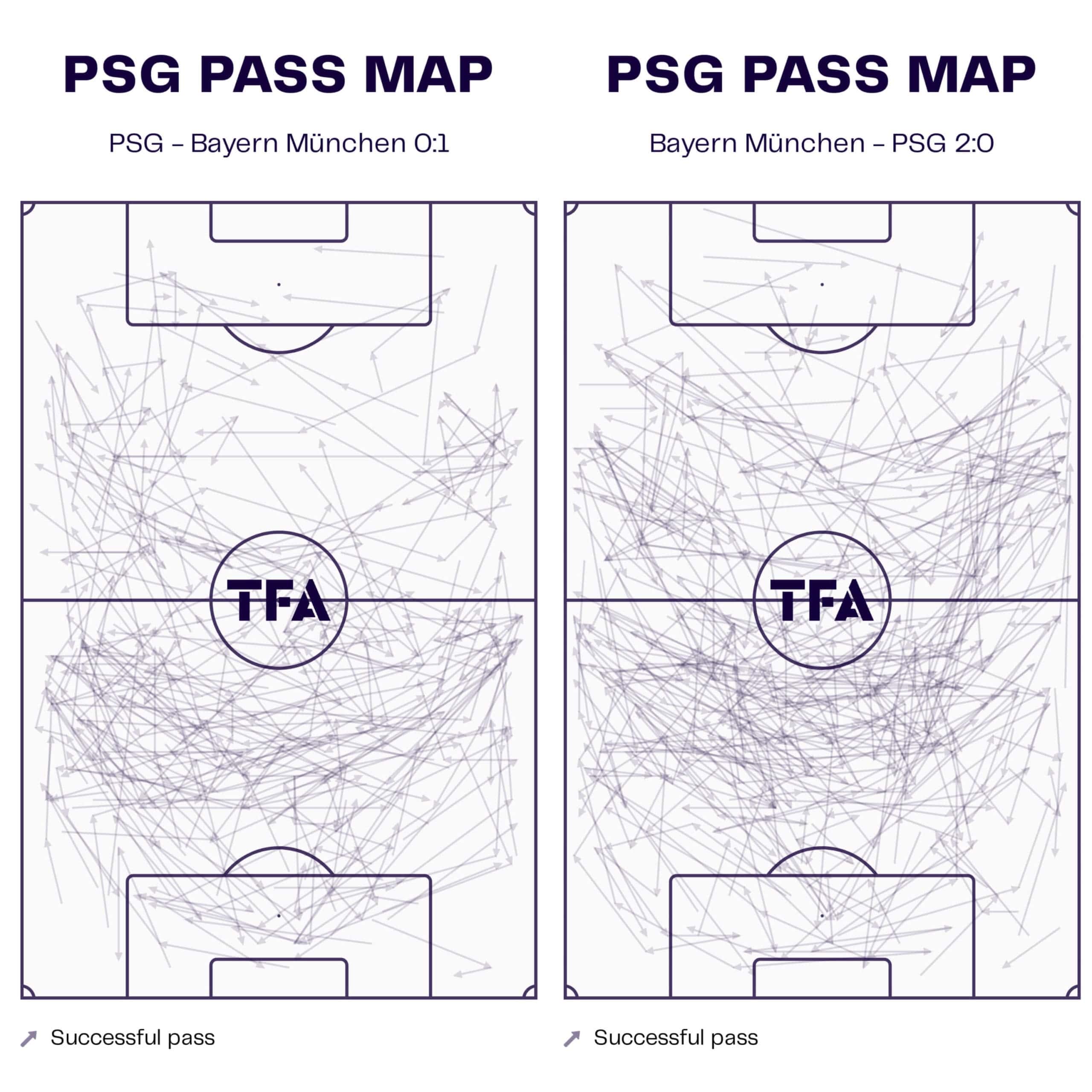
Meanwhile, though they enjoyed some more time on the ball in these areas in the away leg, it’s important to keep in mind many of these passes came when Bayern were already a couple of goals to the good on aggregate and started dropping their defensive line a tad, happier to sit back a bit more while PSG were forced to be braver and step out more.
In the home leg, their forays into the final third came primarily via the left wing, with a heavy reliance on Mbappé as an attacking outlet. This is another common feature of their game over the past couple of seasons.
I don’t blame them for wanting to use their greatest offensive weapon to the fullest but perhaps varying things up a bit more would allow Mbappé to actually shine more rather than over-relying on him and either his movement in behind or his dribbling after receiving the ball to feet, resulting in their attacking play becoming too predictable.
In the away leg, passes to the overlapping Achraf Hakimi became more common, especially in transition, but they failed to create much from these movements despite the way in which the right-back’s forward runs did aid the team’s progression into the final third.
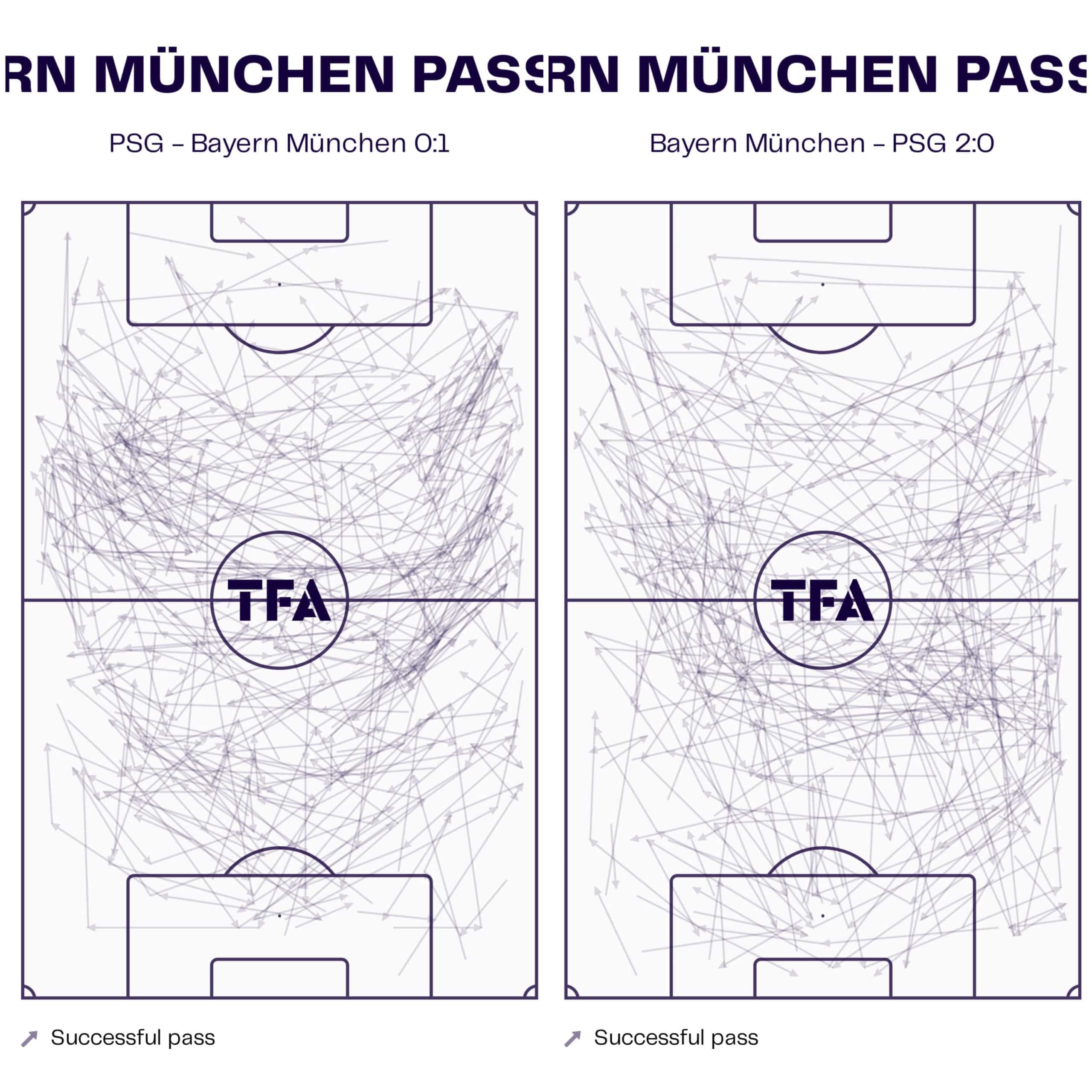
Compare PSG’s pass maps with Bayern’s pass maps and you can see Bayern’s looks much healthier, which greater control of valuable central areas and more settled possession around the halfway line.
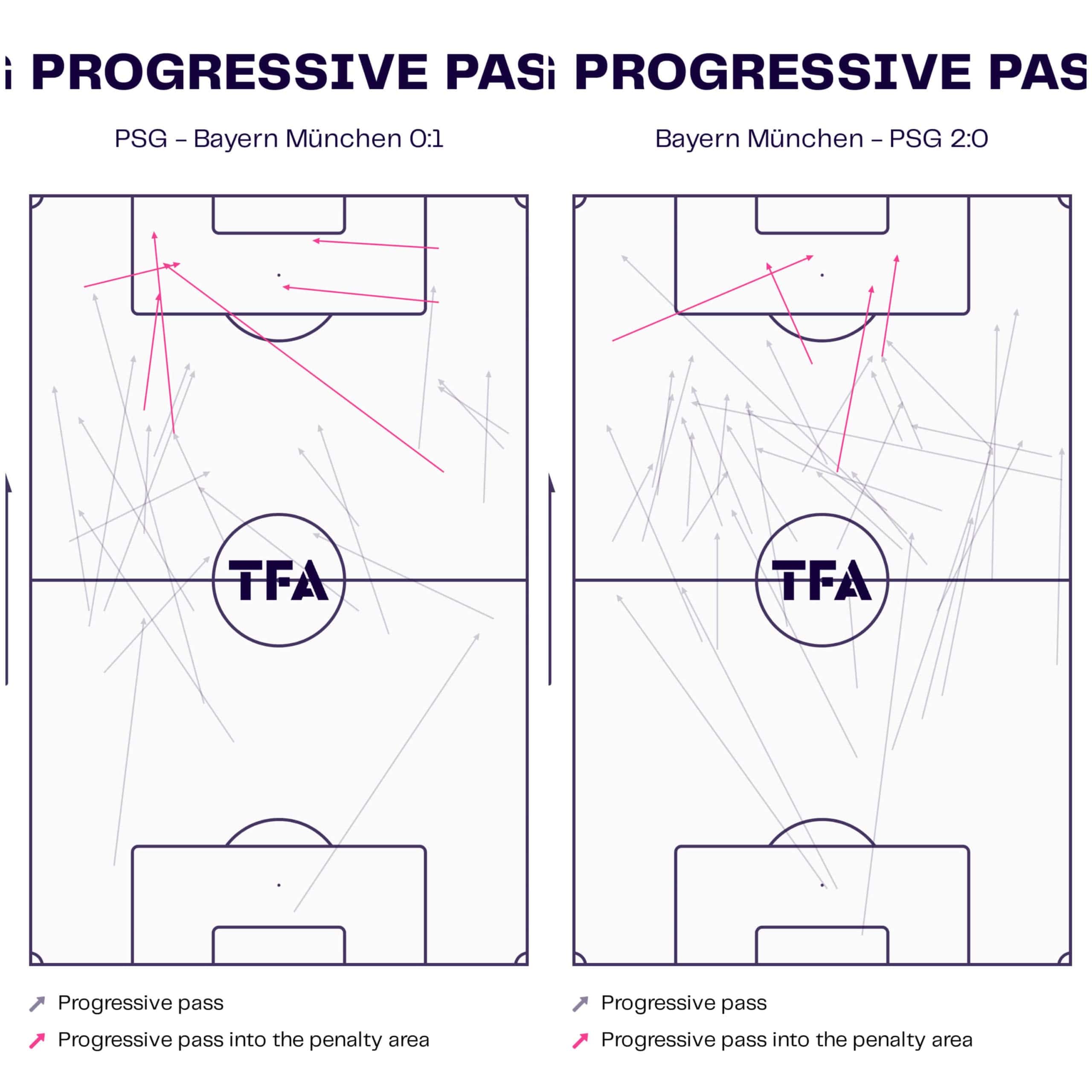
PSG’s progressive passes from the two legs again highlight their general lack of central occupation, though it did improve to an extent in the second leg, and an over-reliance on Mbappé as an outlet, especially in the first leg, on the left wing along with a clear plan to exploit Hakimi’s overlapping runs on the right wing in the second leg — which, ultimately, didn’t produce much.
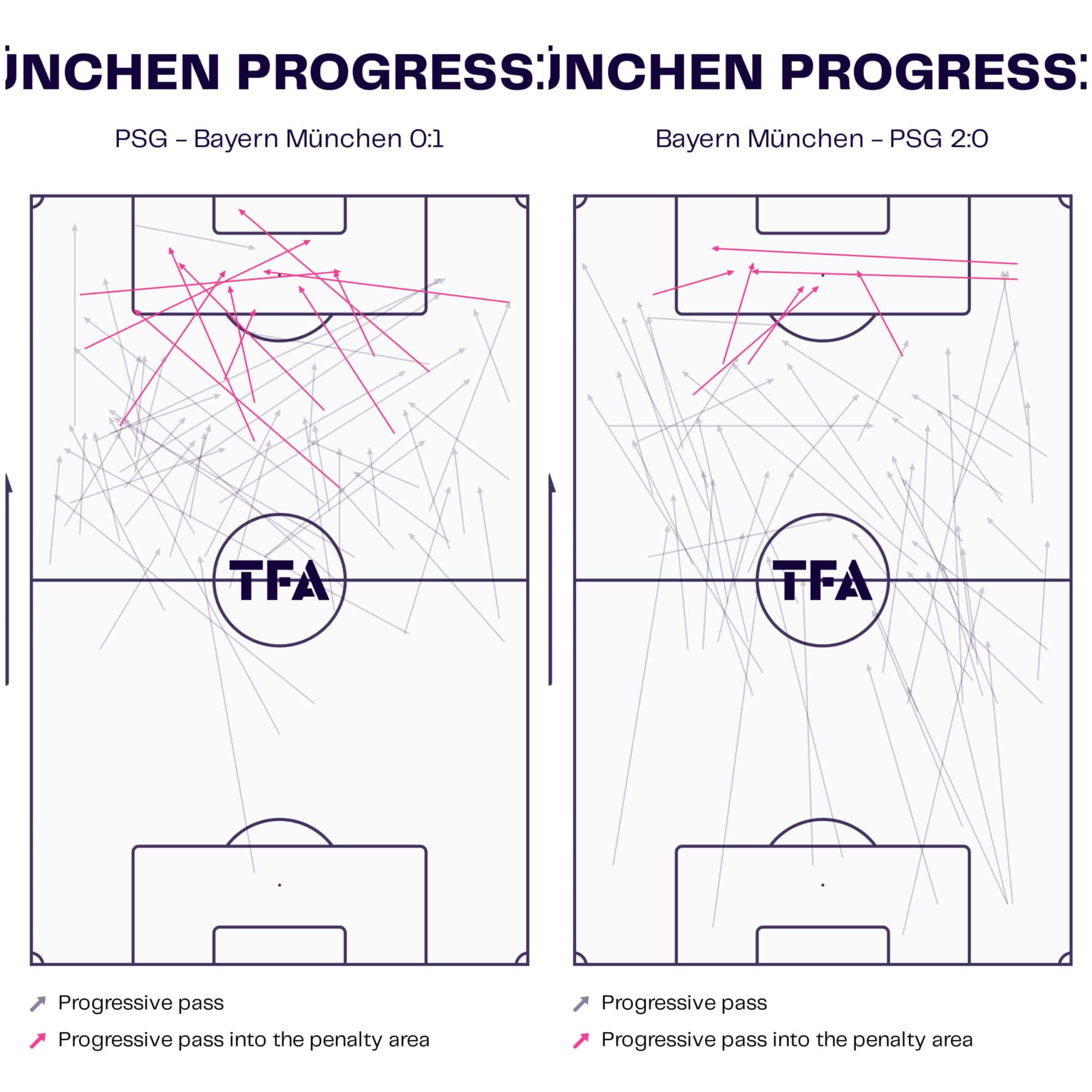
Bayern were not only able to progress into PSG’s half more often, but they were also much more creative in the final third. We also see far more progressive passes coming from deep in Bayern’s progressive passing maps, highlighting how they were far braver in possession and took more risks with the ball.
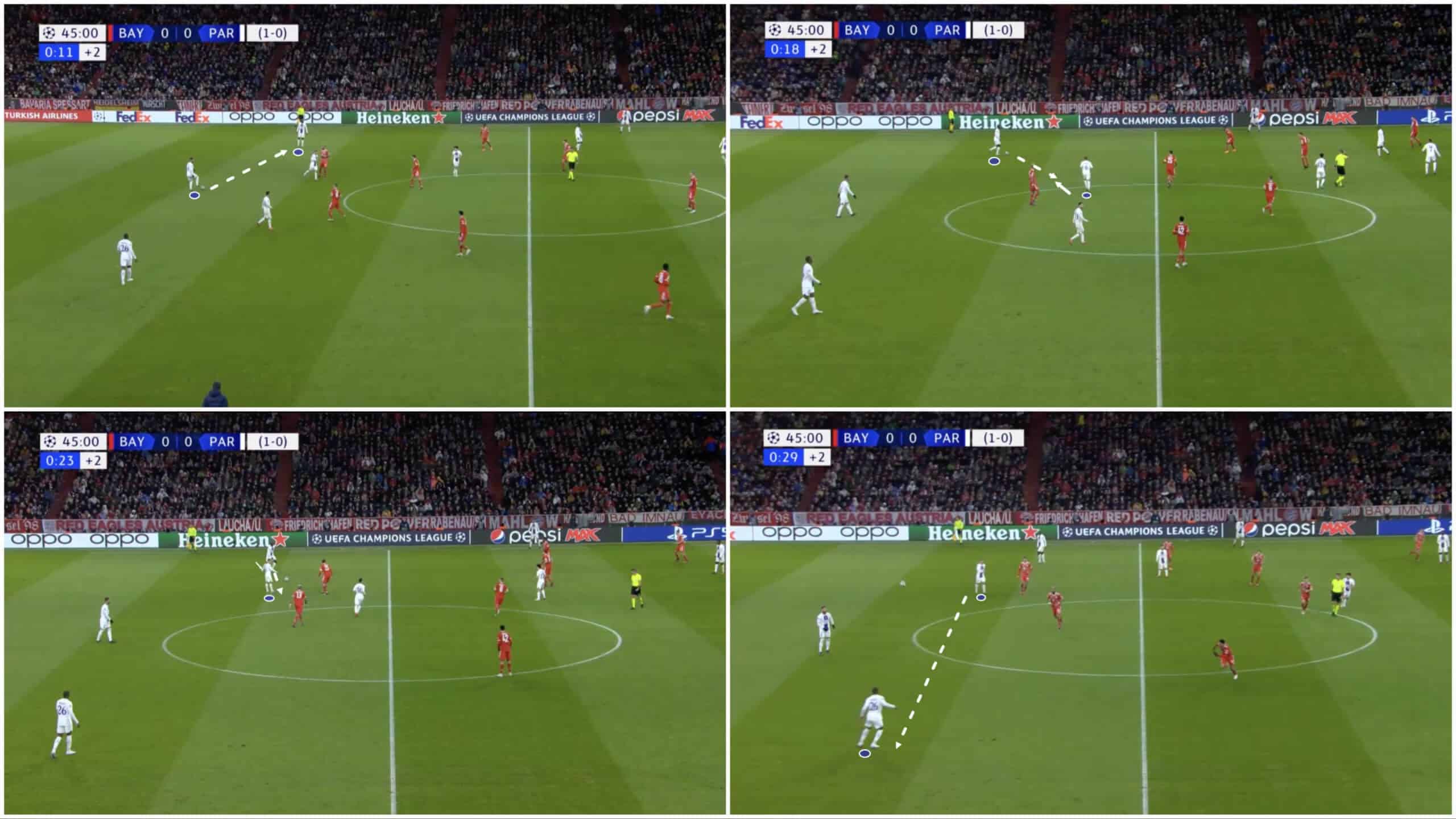
Figure 7 shows a typical PSG build-up sequence. They’ve got a 3-2 structure at the back with five positioned ahead. However, it felt like there was a divide between the players in their own half and the players in the opposition’s half and there was far too much hesitance to cross that divide. Even if players dropped deep from the opposition’s half into PSG’s half, they would just join this deep circulation that Bayern had no problems defending against.
In contrast to PSG, Bayern pressed very effectively, closing off the clear passing lanes into more advanced positions and denying the deep players time and space on the ball to progress. There was a clear difference between the two teams’ intensity off the ball and, as we move on into figure 8, on the ball.
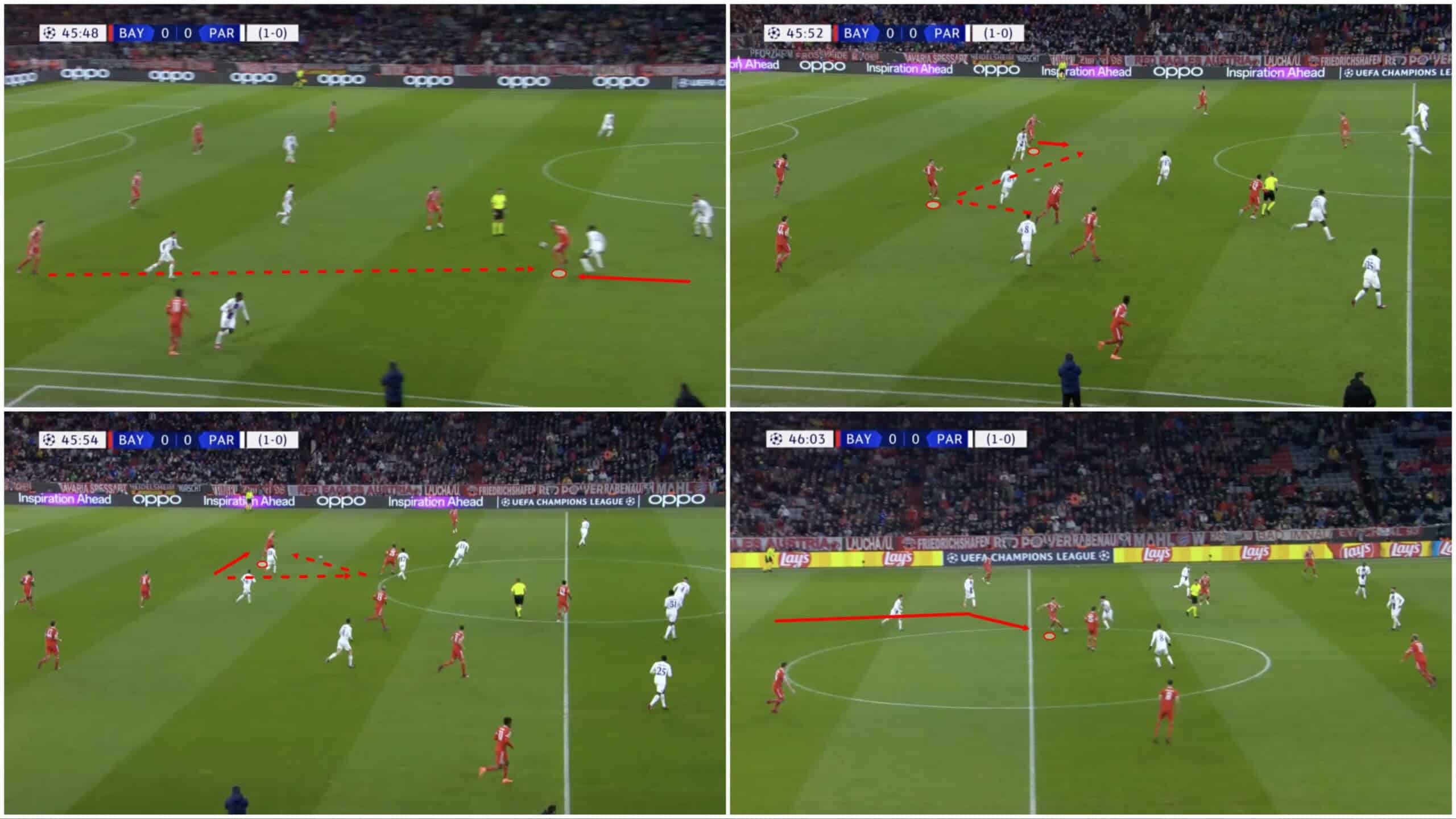
Here, we see a typical example of a Bayern build-up sequence from Wednesday’s game. In contrast to PSG, there’s immediate verticality. Players are looking for forward passing options and daring to make use of them as quickly as possible while remaining reasonably safe. There was much more dynamic movement from Bayern’s attackers and midfielders to give the backline options when looking to progress. This is, again, in contrast to PSG whose attackers and advanced midfielders didn’t offer enough dynamic movement, leading to lethargic build-up.
In possession part 2: Slow build-up creates for the opponent
As a result of their lethargic build-up play, PSG were caught in possession on the edge of their box, allowing Bayern to score their first goal on Wednesday, putting them two goals up on aggregate.
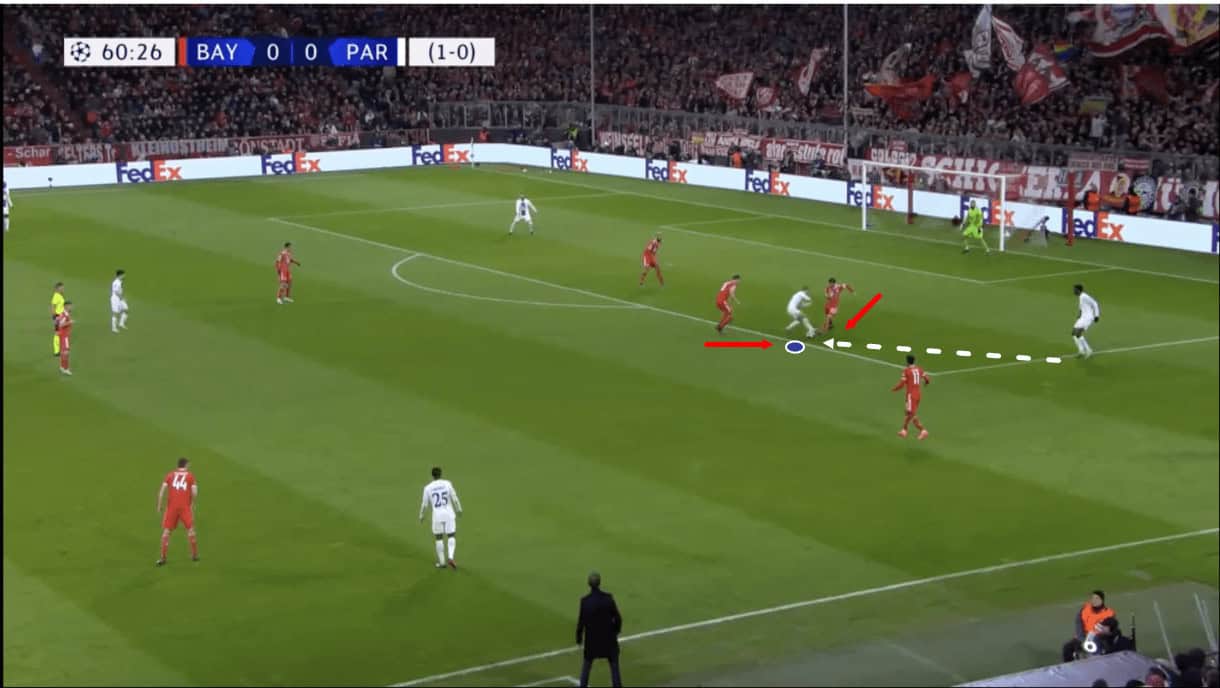
El Chadaille Bitshiabu, at left centre-back, is an exciting talent and one of the best teenage centre-backs in the world. With that said, Bitshiabu played the ball to Marco Verratti and this invited Bayern’s more aggressive press. The Italian — again, a brilliant player — failed to deal with the pressure well and was quickly dispossessed.
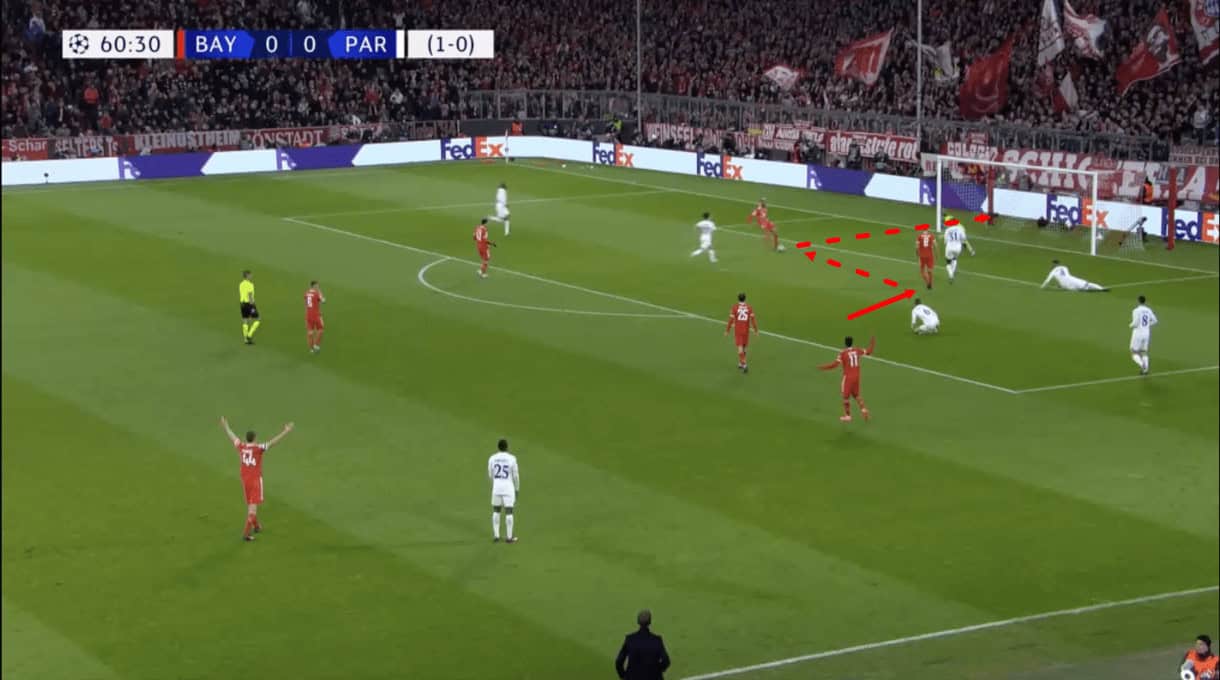
The turnover was quickly turned into a goalscoring opportunity that was converted by former PSG striker Eric Maxim Choupo-Moting.
This incident has been blown up and inevitably fingers have been pointed at individuals but the whole team has to take a lot of responsibility for failing to fix an issue that’s been pestering for weeks and proving problematic.
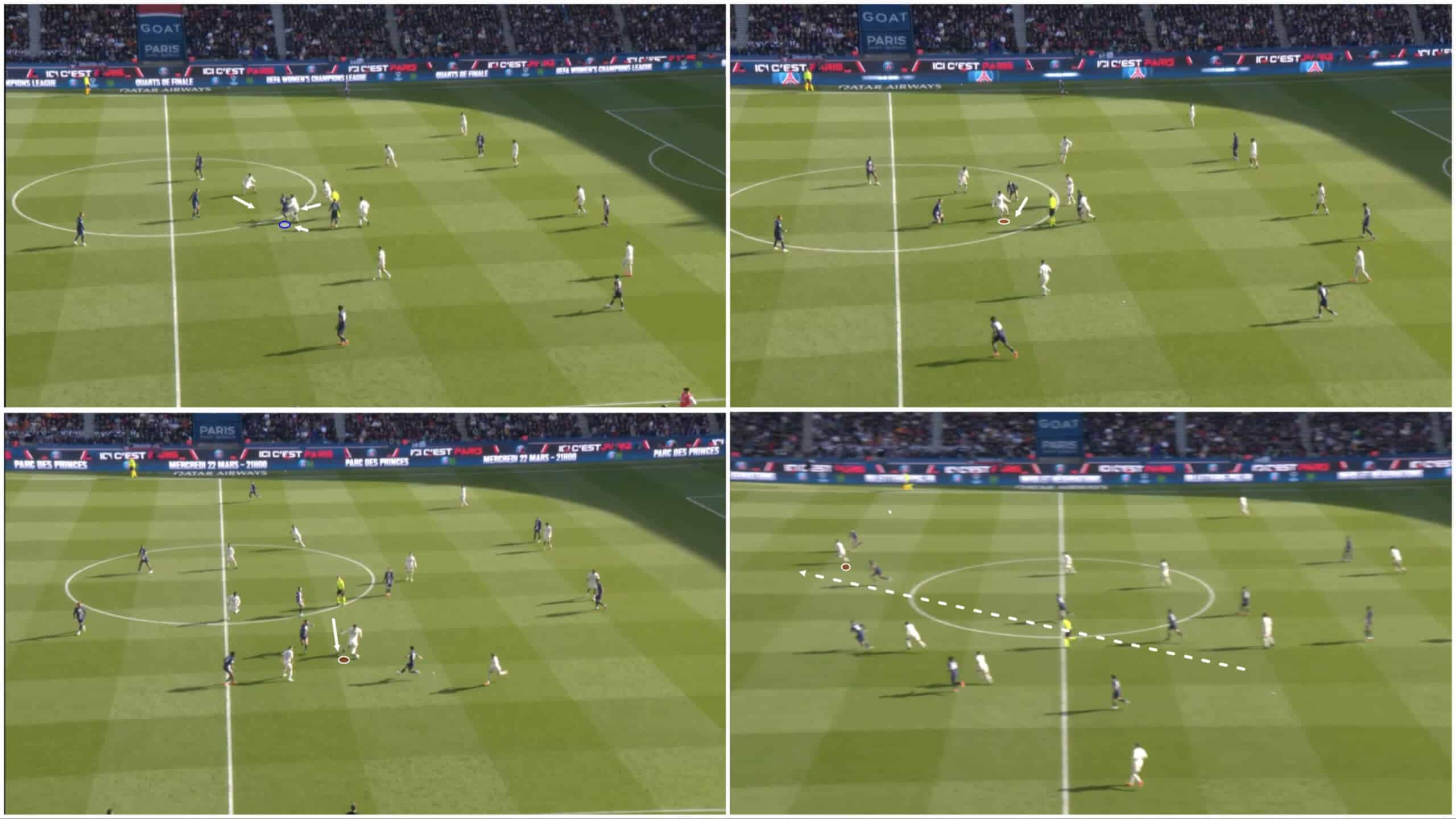
PSG conceded a goal versus Lille in Ligue 1 on the 19th of February after Lille regained possession via some good pressing on Verratti in midfield, allowing the ball to be sent over the top for Jonathan Bamba to convert.
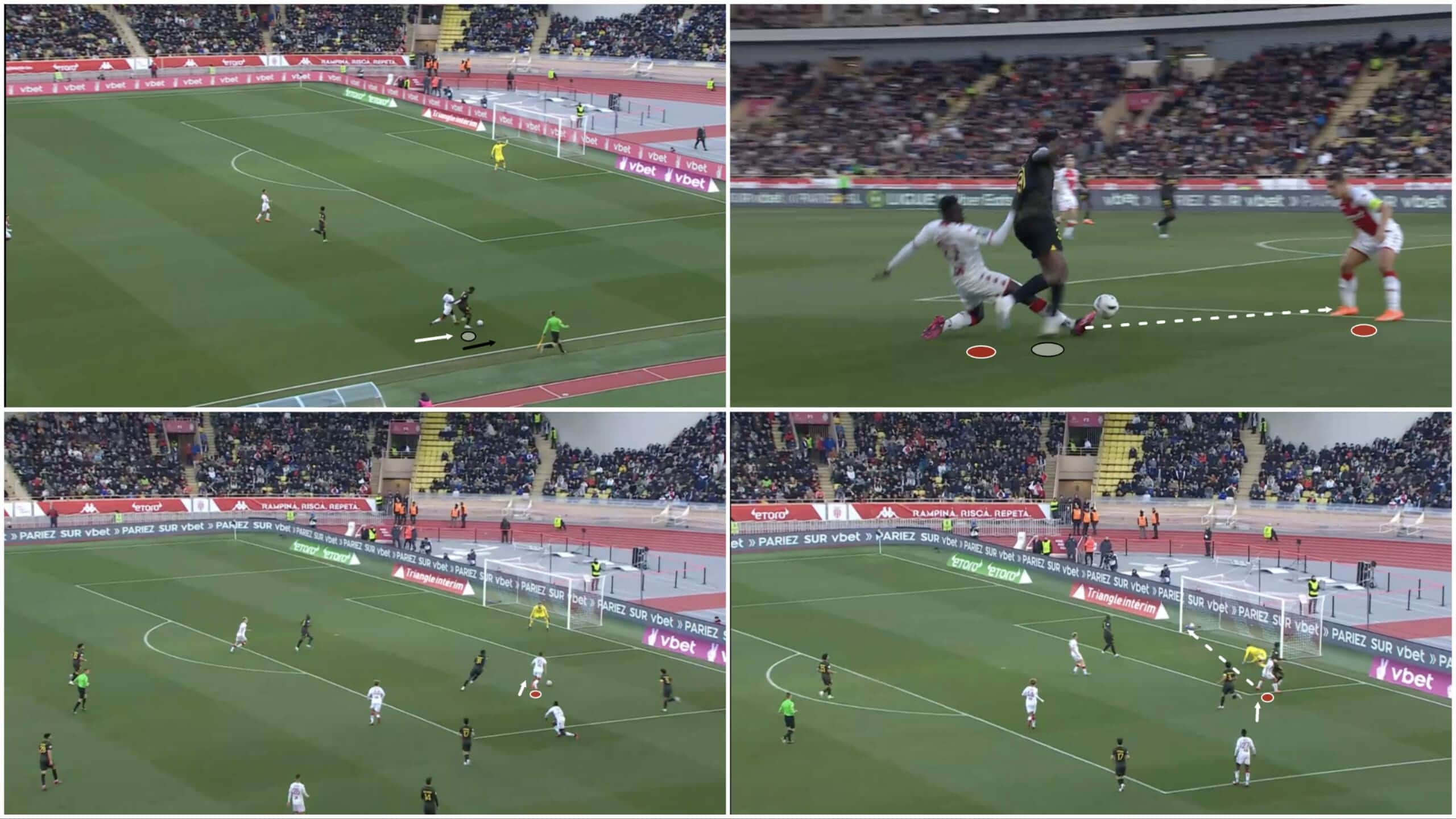
Meanwhile, again Bitshiabu is in the spotlight here, PSG tried to retain possession while under pressure from Monaco, leading to the centre-back being dispossessed on the edge of his box and a great chance being presented to Les Monégasques for Wissam Ben-Yedder to convert.
All of these goals were a result of PSG’s laboured, cautious approach to build-up and ball progression. When this meets an effective, well-organised and intense press, the results can be catastrophic as soon as the turnover occurs and the intensity changes from PSG’s slow build-up to the opposition’s quick counter.
Conclusion
To conclude our tactical analysis, it’s clear that PSG’s UCL exit highlights some major issues for the team in and out of possession. The major overarching theme is a lack of intensity and urgency on and off the ball; you wouldn’t have thought PSG were the team chasing the lead for the majority of this match.
The expectations are sky high in Paris but when you’ve got the personnel they have in the squad and spend the money they have, that’s natural. Christophe Galtier — or, indeed, whoever takes the reins next at Le Parc des Princes — has a big challenge to turn this project from underwhelming into the success it could be.





Comments